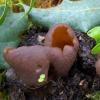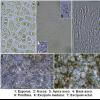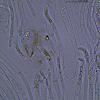
16-09-2013 23:48
Dear all,Have you already observed little apical

15-09-2013 18:29
Hello, I found these yellow things on, what I thin

12-09-2013 21:57
Aouali SouhilaBonsoir,Nous avons rencontre H. juniperina a l'oue

13-09-2013 20:54
Hello to all,anyone have any literature about Cer

12-09-2013 23:38
Hello, Can this be something else then H flaveola?

12-09-2013 18:45
Hi to allMy friend J. Linde found these gregariou

Hola amigos.
Os pongo esta Otidea que encontré el pasado sábado bajo Buxus sempervirens y Quercus ilex con suelo básico.
Ejemplares bastante jóvenes, de 2,5-3 cm de altura, con el himenio de color pardo amarillo o pardo naranja que va oscureciendo al madurar. Excípulo furfuraceo de color pardo liláceo.
Esporas con dos gútulas, excepcionalmente una, de 12,2-15,7 X 5,7-7 micras. Q=1,9(2,2)2,4 n=50
Paráfisis filiformes, multiseptadas, no excesivamente recurvadas, con contenido vacuolar de 2,8(3,7)4,4 micras de anchura.
Ascas 190-253 X 8-12.
Excípulo medular con estructura intricata, sin cristales. Excípulo ectal con estructura globulosa.
Pienso que se trata de Otidea mirabilis. Que os parece?
Saludos,
Carlos

No sé qué valor taxonómico tendrá el ápice de las paráfisis no curvadas, pero prescindiendo de ese carácter, creo que el resto encaja bien. Aquí tienes una (mala) ficha mía de hace bastante tiempo, cuando yo todavía no hacía taxonomía vital
http://www.micobotanicajaen.com/Revista/Articulos/MARibesR/Tenerife003/Otidea%20mirabilis%20221205%2014.pdf
Un saludo

Es cierto que en esta colección la curvatura de las paráfisis no es tan pronunciada como en otras recolectas y la fotografía enviada en bastanta representativa, pero también es cierto que he encontrado, menos frecuentemente, algunas con curvaturas más pronunciadas como las de la foto adjunta.
Saludos,
Carlos

I think this is the same kind of paraphyses that are in bufonia clade (and in some other species too) - although they are nor curved/hooked here, they are neither clavate nor capitate and some have a slight apical swelling on the lower side. I've mostly seen straighter and almost cylindric paraphyses on younger apothecia. The overall color and spore shape should too exclude other species than bufonia+mirabilis.
Carlos, did you observe those hyaline to light brown flabellate exudates in medulla? They are sometimes rather inconspicuous. If you have polarisation microscope (or two polarisation filters for photocamera), it would be easier to locate them (see photo).
Best regards,
Viktorie

Saludos,
Carlos

Viktorie





